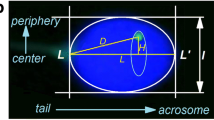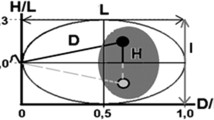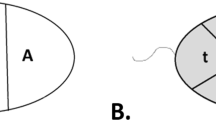Abstract
Evidence has been accumulating that individual chromosomes in human sperm cells occupy defined, non-random positions. Our earlier study suggested that abnormal spermatogenesis in carriers of reciprocal translocations was reflected in the changes in the intranuclear topology of sperm chromosomes. The purpose of this study was to determine whether the increased level of disomy of sperm chromosomes may be the factor that can disturb topology within the sperm nuclei. The results obtained indicated that within the sperm nuclei of fertile individuals the centromeres of chromosomes 15, 18, X and Y were localized in a small area that may be a fragment of the chromocentre. When compared with the intranuclear positions of the same chromosomes in sperm nuclei of infertile patients with an increased level of aneuploidy, some disturbances in the centromere area were found. In disomic sperm cells (n + 1) centromeres 15,15 or 18,18 or YY (but not X,X) had a shifted average longitudinal position in comparison with normal sperm cells (n = 23).
Similar content being viewed by others
References
Aoki VW, Carrell DT (2003) Human protamines and the developing spermatid: their structure, function, expression and relationship with male infertility. Asian J Androl 5: 315–324.
Biggers JD, Whitt WK, Whittingham DG (1971) The culture of mouse embryos in vitro. In: Daniel JC, ed. Methods in Mammalian Embryology. San Francisco: Freeman WH Co., pp. 86–116.
Braun RE (2001) Packaging paternal chromosomes with protamine. Nat Genet 28: 10–12.
Celik-Ozenci C, Catalanotti J, Jakab A et al. (2003) Human sperm maintain their shape following decondensation and denaturation for fluorescent in situ hybridization: shape analysis and objective morphometry. Biol Reprod 69: 1347–1355.
Cremer T, Cremer C (2001) Chromosome territories, nuclear architecture and gene regulation in mammalian cells. Nat Rev Genet 2: 292–301.
Ferlin A, Arredi B, Foresta C (2006) Genetic causes of male infertility. Reprod Toxicol 22: 133–141.
Finch KA, Fonseka KGL, Abogrein A et al. (2008) Nuclear organization in human sperm: preliminary evidence for altered sex chromosome centromere position in infertile males. Hum Reprod 23: 1263–1270.
Ford WCL (2001) Biological mechanisms of male infertility. Lancet 357: 1223–1224.
Foster HA, Abeydeera LR, Griffin DK, Bridger JM (2005) Non-random chromosome positioning in mammalian sperm nuclei, with migration of the sex chromosomes during late spermatogenesis. J Cell Sci 118: 1811–1820.
Fraser L (2004) Structural damage to nuclear DNA in mammalian spermatozoa: its evaluation techniques and relationship with male infertility. Pol J Vet Sci 7: 311–321.
Garagna S, Zuccotti M, Thornhill A et al. (2001) Alteration of nuclear architecture in male germ cells of chromosomally derived subfertile mice. J Cell Sci 114: 4429–4434.
Gazvani MR, Wilson ED, Richmond DH, Howard PJ, Kingsland CR, Lewis-Jones DI (2000) Role of mitotic control in spermatogenesis. Fertil Steril 74(2): 251–256.
Greaves IK, Rens W, Ferguson-Smith MA, Griffin D, Marshall Graves JA (2003) Conservation of chromosome arrangement and position of the X in mammalian sperm suggests functional significance. Chromosome Res 11: 503–512.
Gurevitch M, Amiel A, Ben-Zion M, Fejgin M, Bartoov B (2001) Acrocentric centromeres organization within the chromocenter of the human sperm nucleus. Mol Reprod Dev 60: 507–516.
Haaf T, Ward DC (1995) Higher order nuclear structure in mammalian sperm revealed by in situ hybridization and extended chromatin fibers. Exp Cell Res 219: 604–611.
Hazzouri M, Rousseaux S, Mongelard F et al. (2000) Genome organization in the human sperm nucleus studied by FISH and confocal microscopy. Mol Reprod Dev 55: 307–315.
Hoyer-Fender S, Singh PB, Motzkus D (2000) The murine heterochromatin protein M31 is associated with the chromocenter in round spermatids and is a component of mature spermatozoa. Exp Cell Res 254: 72–79.
Luetjens CM, Payne C, Schatten G (1999) Non-random chromosome positioning in human sperm and sex chromosome anomalies following intracytoplasmic sperm injection. Lancet 353: 1240.
Martianov I, Brancorsini S, Gansmuuler A, Parvinen M, Davidson I, Sassone-Corsi P (2002) Distinct functions of TBP and TLF/TRF2 during spermatogenesis: requirement of TLF for heterochromatic chromocenter formation in haploid round spermatids. Development 129: 945–955.
Martin RH (1983) A detailed method for obtaining preparations of human sperm chromosomes. Cytogenet Cell Genet 35(4): 252–256.
Martin RH (2005) Mechanisms of nondysjunction in human spermatogenesis. Cytogenet Genome Res 111: 245–249.
Martin RH, Rademaker AW, Greene C et al. (2003) A comparison of the frequency of sperm chromosome abnormalities in men with mild, moderate, and severe oligozoospermia. Biol Reprod 69: 535–539.
Martinez-Pasarell O, Marquez C, Coll MD, Egozcue J, Templado C (1997) Analysis of human sperm-derived pronuclei by three-colour fluorescent in-situ hybridization. Hum Reprod 12(4): 641–645.
Martins RP, Ostermeier GC, Krawetz SA (2004) Nuclear matrix interactions at the human protamine domain. J Biol Chem 279: 51862–51868.
Meaburn KJ, Misteli T (2007) Chromosome territories. Nature 445: 379–381.
Moskovtsev S, White J, Wilis J, Mulle BN (2007) Disrupted telomere–telomere interactions are associated with DNA damage in human spermatozoa. Personal communication: Florence – Utah International Symposium ‘Genetics of Male Infertility’, Florence, 14–16 September 2007.
Mudrak O, Tomilin N, Zalensky AO (2005) Chromosome architecture in the decondensing human sperm nucleus. J Cell Sci 118: 4541–4550.
Oliver-Bonet M, Ko E, Martin RH (2005) Male infertility in reciprocal translocation carriers: the sex body affair. Cytogenet Genome Res 111: 343–346.
Sakkas D, Moffatt O, Manicardi GC, Mariethoz E, Tarozzi N, Bizzaro D (2002) Nature of DNA damage in ejaculated human spermatozoa and the possible involvement of apoptosis. Biol Reprod 66: 1061–1067.
Sassone-Corsi P (2002) Unique chromatin remodeling and transcriptional regulation in spermatogenesis. Science 296: 2176–2178.
Sbracia M, Baldi M, Cao D et al. (2002) Preferential location of sex chromosomes, their aneuploidy in human sperm, and their role in determining sex chromosome aneuploidy in embryos after ICSI. Hum Reprod 17: 320–324.
Solov’eva L, Svetlova M, Bodinski D, Zalensky AO (2004) Nature of telomere dimers and chromosome looping in human spermatozoa. Chromosome Res 12: 817–823.
Taddei A, Hediger F, Neumann FR, Gasser SM (2004) The function of nuclear architecture: a genetic approach. Annu Rev Genet 38: 305–345.
Tempest HG, Griffin DK (2004) The relationship between male infertility and increased levels of sperm disomy. Cytogenet Genome Res 107(1–2): 83–94.
Terada Y, Luetjens CM, Sutovsky P, Schatten G (2000) Atypical decondensation of the sperm nucleus, delayed replication of the male genome, and sex chromosome positioning following intracytoplasmic human sperm injection (ICSI) into golden hamster eggs: does ICSI itself introduce chromosomal anomalies? Fertil Steril 74: 454–460.
Tilgen N, Guttenbach M, Schmid M (2001) Heterochromatin is not an adequate explanation for close proximity of interphase chromosomes 1–9, 9–Y, and 16–Y in human spermatozoa. Exp Cell Res 265: 283–287.
Ward MA, Ward WS (2004) A model for the function of Sperm DNA degradation. Reprod Fertil Dev 16: 547–554.
WHO (World Health Organization) (1999) Laboratory Manual for the Examination of Human Semen and Sperm–Cervical Mucus Interaction, 4th edn. Cambridge, UK: Cambridge University Press, pp. 60–61.
Wiland E, Wojda A, Kamieniczna M, Latos-Bieleńska A, Jedrzejczak P, Kurpisz M (2001) Idiopathic infertility in married couples in the light of cytogenetic analysis and sperm penetration assay. Folia Histochem Cytobiol 39(1): 35–41.
Wiland E, Wojda A, Kamieniczna M, Szczygieł M, Kurpisz M (2002) Infertility status of male individuals with abnormal spermiogram evaluated by cytogenetic analysis and in vitro sperm penetration assay. Med Sci Monit May, 8(5): CR394–400.
Wiland E, Żegało M, Kurpisz M (2008) Interindividual differences and alterations in the topology of chromosomes in human sperm nuclei of fertile donors and carriers of reciprocal translocations. Chromosome Res 16: 291–305.
Wykes SM, Krawetz SA (2003) The structural organization of sperm chromatin. J Biol Chem 278: 29471–29477.
Zalenskaya IA, Zalensky AO (2002) Telomeres in mammalian male germ cells. Int Rev Cytol 218: 37–67.
Zalenskaya IA, Zalensky AO (2004) Non-random positioning of chromosomes in human sperm nuclei. Chromosome Res 12: 163–173.
Zalensky AO, Allen MJ, Kobayashi A, Zalenskaya IA, Balhorn R, Bradbury EM (1995) Well-defined genome architecture in the human sperm nucleus. Chromosoma 103: 577–590.
Author information
Authors and Affiliations
Corresponding author
Rights and permissions
About this article
Cite this article
Olszewska, M., Wiland, E. & Kurpisz, M. Positioning of chromosome 15, 18, X and Y centromeres in sperm cells of fertile individuals and infertile patients with increased level of aneuploidy. Chromosome Res 16, 875–890 (2008). https://doi.org/10.1007/s10577-008-1246-2
Received:
Revised:
Accepted:
Published:
Issue Date:
DOI: https://doi.org/10.1007/s10577-008-1246-2




